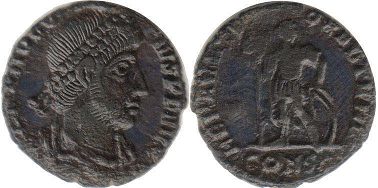Coins of Procopius - catalog with values
Roman Emperor (365-366)

D N PROCOPIVS P F AVG
REPARATIO FEL TEMP
364-378
copper
Constantinople
18 mm.
Bust right in draped armor and diadem / Our Lord Procopius Pious Happy Augustus
Emperor standing, holds labarum and shield / Returning of Happy Times
Coin value ~ US$150-200
Costs of Procopius coins in this catalog approximate and indicated specifically for the coin shown in the picture.
I do not buy or sell coins - this is just a catalog.
See other coins of Imperial Rome.

